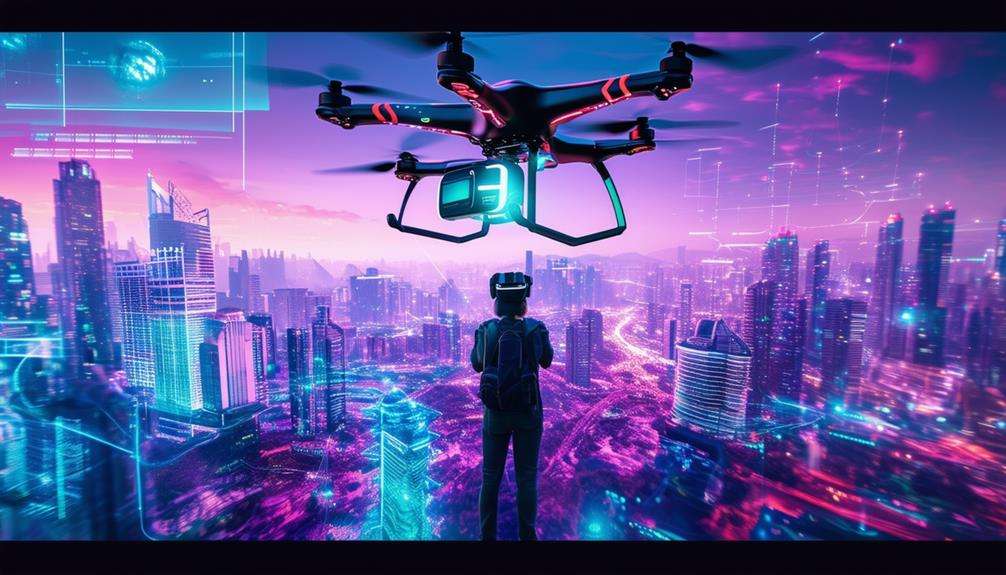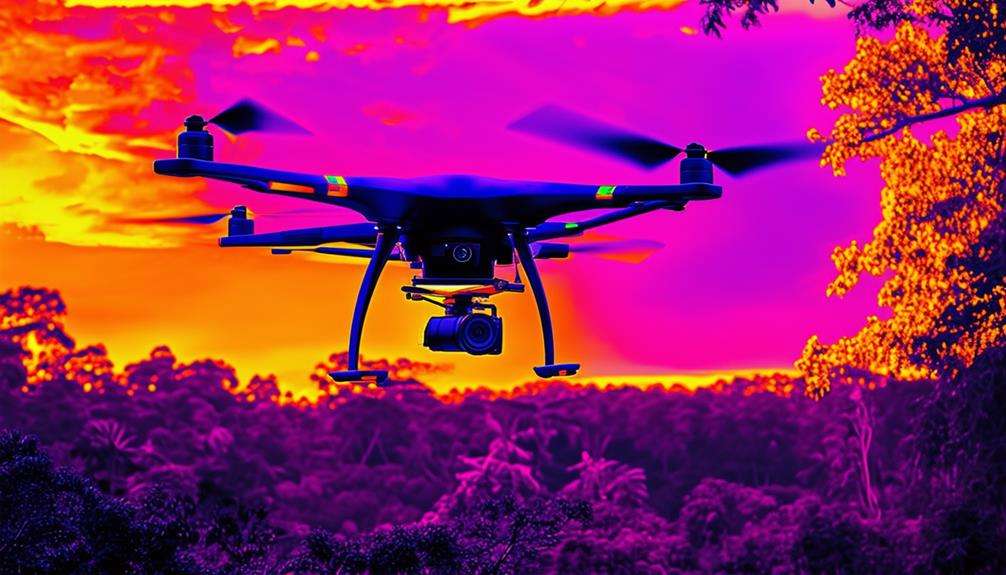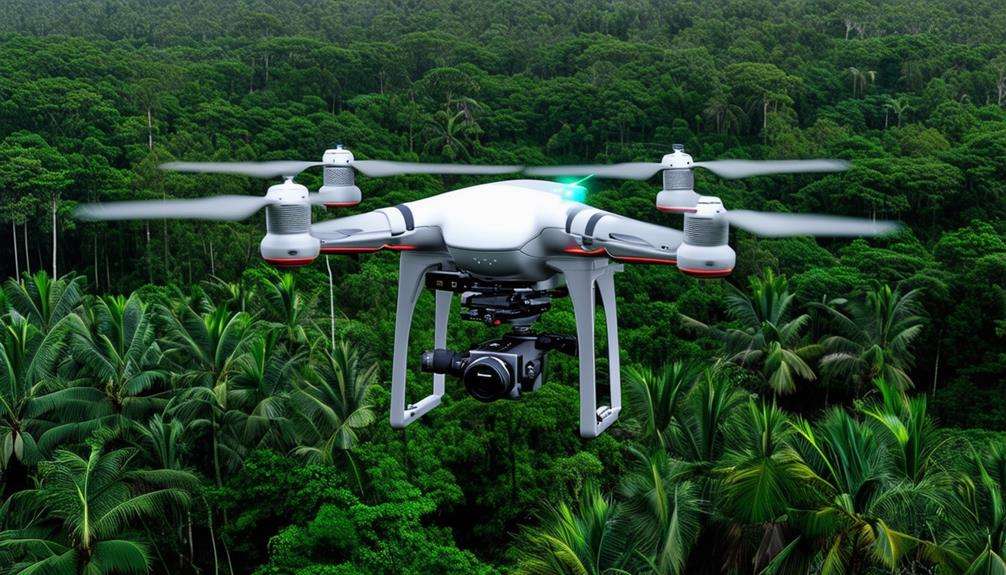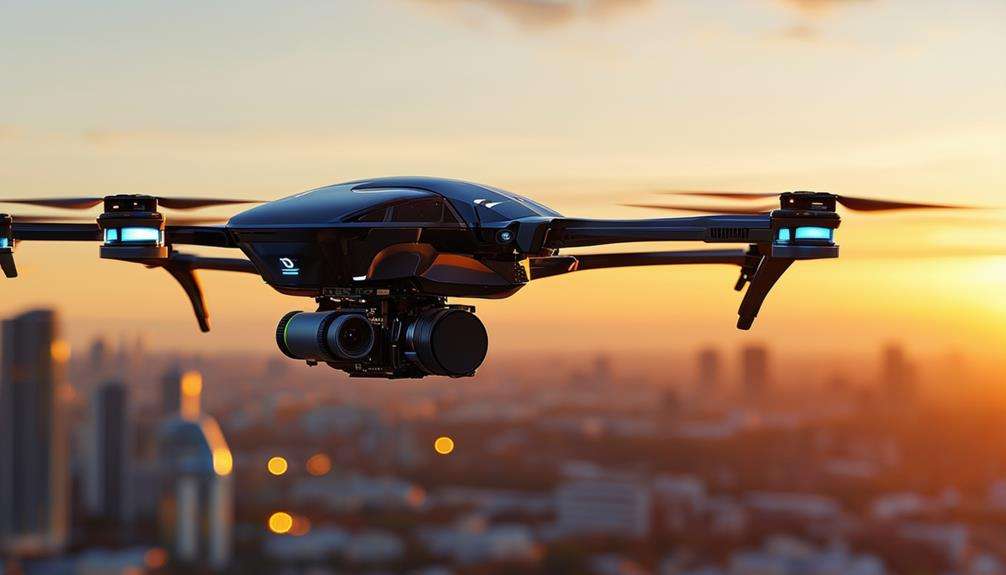Drone Technology: How Drones Work
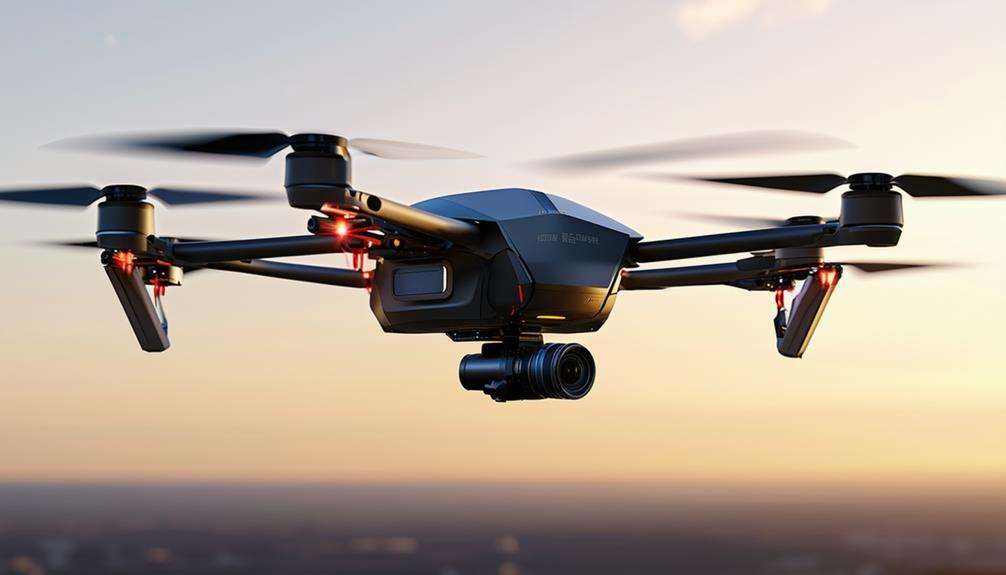
When you consider drone technology, you might wonder how these devices stay airborne and navigate with such precision. The core components of a drone's operation are its propulsion systems, flight controllers, and advanced sensors. These elements work in harmony to ensure stable and controlled flight.
For example, the flight controller continuously processes data from various sensors to adjust the drone's movements in real time. What exactly happens inside these high-tech machines that enables them to perform such complex tasks? To understand this, you need to delve into the specifics of each component and how they interact.
What Are Drones?
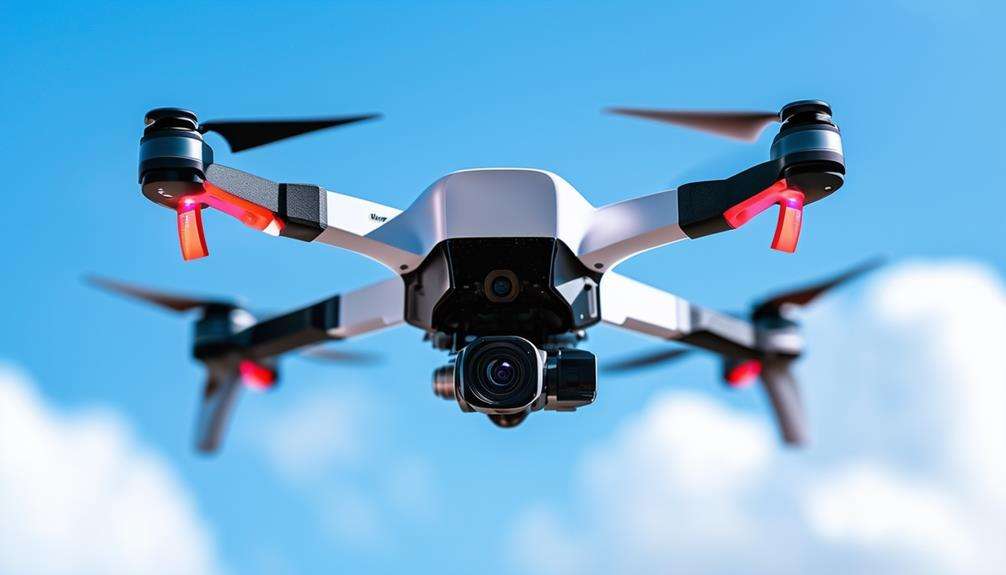
Drones are versatile unmanned aerial vehicles (UAVs) that can be controlled remotely or programmed to fly autonomously. Equipped with advanced technologies, they're capable of performing sophisticated flight maneuvers. Most drones feature multiple propellers that work together to provide lift and thrust, ensuring stable and controlled flight.
Central to a drone's functionality is the flight controller, an onboard computer that processes data from various sensors to adjust the drone's movements in real-time. This system ensures stability, accurate navigation, and responsiveness to commands or pre-set flight paths.
Many modern drones are also equipped with obstacle avoidance features, utilizing sensors such as GPS, radar, and infrared to detect and navigate around obstacles automatically.
These capabilities make drones invaluable across various industries. They're used for search and rescue operations, agricultural monitoring, and traffic surveillance, offering reliable and efficient solutions for tasks that are challenging or hazardous for humans.
Components of a Drone
To understand how drones operate, you need to examine their key components:
Propulsion and flight control, navigation and GPS systems, and sensors and cameras. These elements work together to ensure smooth flight and accurate maneuvering. Let's break down how each part contributes to a drone's overall functionality.
Propulsion and Flight Control
Mastering drone propulsion and flight control requires understanding the interplay between motors, propellers, and sophisticated electronic systems. Propulsion is primarily achieved through the synergy of motors and propellers. Motors provide the necessary power, while propellers convert this power into lift and thrust, enabling the drone to take off, hover, and maneuver.
Electronic speed controllers (ESCs) are crucial in the flight control system. They regulate motor speeds, ensuring the drone remains stable and responsive to user commands. By adjusting motor speeds, ESCs help maintain balance and control, especially during complex maneuvers.
The flight controller serves as the drone's brain, processing data from sensors like gyroscopes and accelerometers to determine orientation and position. It then sends signals to the ESCs to adjust motor speeds, keeping the drone stable and on course.
Propellers also significantly impact flight control. Their design and configuration affect stability and maneuverability. Fine-tuning propellers and motors can optimize drone performance and responsiveness.
Navigation and GPS Systems
Navigation and GPS systems are crucial for guiding drones with precision and reliability, building upon the foundations of propulsion and flight control. GPS technology enables drones to follow pre-programmed routes, maintain position stability, and return to a designated home point, ensuring a seamless and controlled flight experience.
These systems utilize satellite signals to calculate position, altitude, and speed accurately. This data is essential for precise flight control, allowing the drone to navigate complex environments effortlessly. The real-time telemetry data provided by GPS-enabled drones enhances situational awareness, giving operators better control over the drone's movements.
You can monitor the drone's position, speed, and altitude, making necessary adjustments to ensure smooth and safe operation. The integration of GPS technology in drones extends beyond navigation; it also enhances safety and efficiency. Whether flying in an open field or a crowded urban landscape, GPS systems ensure that the drone operates within specified parameters, reducing the risk of accidents. Thus, navigation and GPS systems are indispensable components that significantly enhance the functionality and reliability of modern drones.
Sensors and Cameras
Equipping drones with advanced sensors and cameras transforms them into versatile tools for a wide range of applications, from agriculture to emergency response. Different sensors like LiDAR, Thermal, ToF (Time of Flight), and Multispectral enable drones to gather critical data in various environments. For instance, in agriculture, multispectral sensors can monitor crop health, while thermal sensors are invaluable in firefighting and search-and-rescue operations.
Camera technology on drones has also advanced significantly. Models such as the DJI Zenmuse Z3 and Z30, along with the Walkera Voyager 4 and 5, offer varying optical zoom capabilities, making them ideal for aerial photography and videography. These cameras capture detailed images and videos from a distance, providing valuable insights and perspectives.
Gimbals play a crucial role in stabilizing these cameras, ensuring smooth and steady footage even during flight. However, with the introduction of Ambarella's H22 chip, drones can now record 4K HD video without the need for a camera gimbal, greatly enhancing the quality of aerial footage. This technological advancement opens new possibilities for high-quality data collection and analysis.
Aerodynamics and Lift
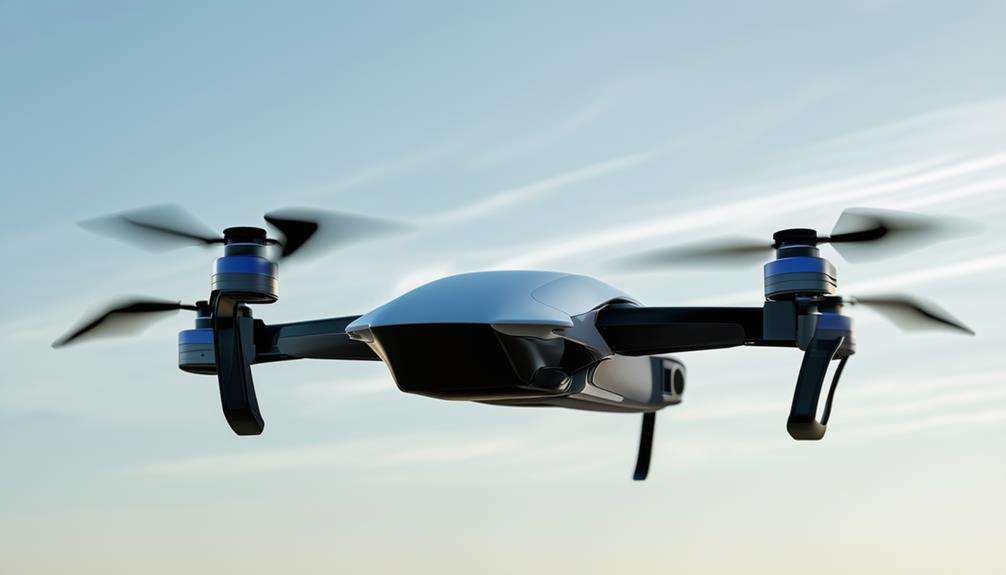
Understanding aerodynamics and lift is essential for mastering drone flight. The interaction between airflow and the drone's propellers produces the lift force needed to counteract gravity. To achieve optimal performance and stability, it's crucial to understand the principles of lift generation and control mechanisms.
Principles of Drone Flight
Understanding how drones achieve flight involves grasping key aerodynamic principles, particularly how lift is generated. The lift force arises from the fluid dynamics of air moving around the drone's propellers. Essentially, the propellers create pressure differences: faster-moving air below the propellers leads to lower pressure, while slower-moving air above results in higher pressure, generating lift.
Here's a concise breakdown:
| Concept | Explanation |
|---|---|
| Lift Force | Created by pressure differences around the propellers. |
| Fluid Dynamics | Governs the airflow around the drone, essential for lift and thrust. |
| Conservation of Energy | Ensures stable flight by balancing energy in the fluid flow. |
Understanding fluid dynamics is crucial for knowing how drones ascend, hover, and maneuver. The conservation of energy principles ensure that the lift force is efficiently utilized, enabling controlled and sustained flight. Mastering these concepts helps appreciate the intricate balance that keeps drones airborne and allows them to perform complex aerial tasks.
Airflow and Lift Generation
Expanding upon the principles of drone flight, let's delve into how the airflow around the propellers generates the lift essential for keeping drones airborne. When the propellers spin, they push air molecules downward, creating a pressure difference above and below the propellers. This pressure difference produces a lift force that counteracts gravity, allowing the drone to stay aloft.
To achieve efficient lift and propulsion, drones leverage aerodynamic principles. The shape and angle of the propeller blades are meticulously designed to optimize airflow, maximizing lift while minimizing drag. Understanding fluid dynamics is crucial in this process, as it helps predict how air will move around the propellers and the drone's body.
Key points to consider:
- Propeller Dynamics: Spinning propellers push air downward, generating an upward lift force.
- Pressure Differences: Varying pressures above and below the propellers create the necessary lift.
- Aerodynamic Design: The shape and angle of propeller blades are critical for optimizing airflow and lift.
- Fluid Dynamics: Knowledge of fluid dynamics aids in optimizing lift and propulsion.
- Energy Conservation: The lift force is influenced by the conservation of energy in the surrounding airflow.
Stability and Control Mechanisms
Stability and control in drones depend on precise aerodynamic adjustments and lift generation, ensuring smooth and responsive flight. These mechanisms work in tandem to maintain balance and direction in the air.
Aerodynamic principles dictate that the lift force, generated by the propellers, counters gravity to keep the drone airborne. This lift is crucial for stability, as any imbalance can lead to erratic movements. Proper control systems adjust pressure variances across the drone's structure to generate the necessary lift and thrust forces, ensuring smooth hovering, ascending, and descending.
The flow pattern around the propellers is critical for creating the lift needed for aerial maneuvers. By manipulating the speed and angle of the propellers, the drone's direction and stability can be precisely controlled. The conservation of energy in fluid dynamics ensures that the generated lift is both efficient and sufficient for maintaining flight.
Understanding these aerodynamics and lift mechanisms highlights how drones achieve stability and control, enabling precise and reliable operation in diverse conditions.
Propulsion Systems
Drones rely on sophisticated propulsion systems that seamlessly integrate motors, Electronic Speed Controllers (ESCs), and propellers to achieve controlled flight. These components work in harmony to provide the necessary thrust and maneuverability. The motors generate the power needed to lift the drone, while ESCs regulate motor speed, ensuring precise control and stability. Additionally, ESCs supply critical data such as braking and fault tolerance, enhancing the overall flight security of the drone.
The propulsion system consists of several integral parts, including motor stators, motor bells, windings, bearings, cooling systems, and wiring. Each component plays a pivotal role in the efficiency and reliability of the drone's operation. Well-tuned ESCs can dynamically adjust motor speed, enabling smooth and responsive flight.
Here are the key components and their functions:
- Motor Stators: Create the electromagnetic field necessary to rotate the motor.
- ESCs: Manage motor speed, braking, and provide fault tolerance.
- Propellers: Convert motor torque into thrust for lift and movement.
- Bearings: Minimize friction, ensuring smooth motor operation.
- Cooling Systems: Prevent overheating, ensuring longevity and reliability.
Understanding these elements helps you appreciate the technology that enables drones to fly effectively and securely.
Flight Controllers and Sensors
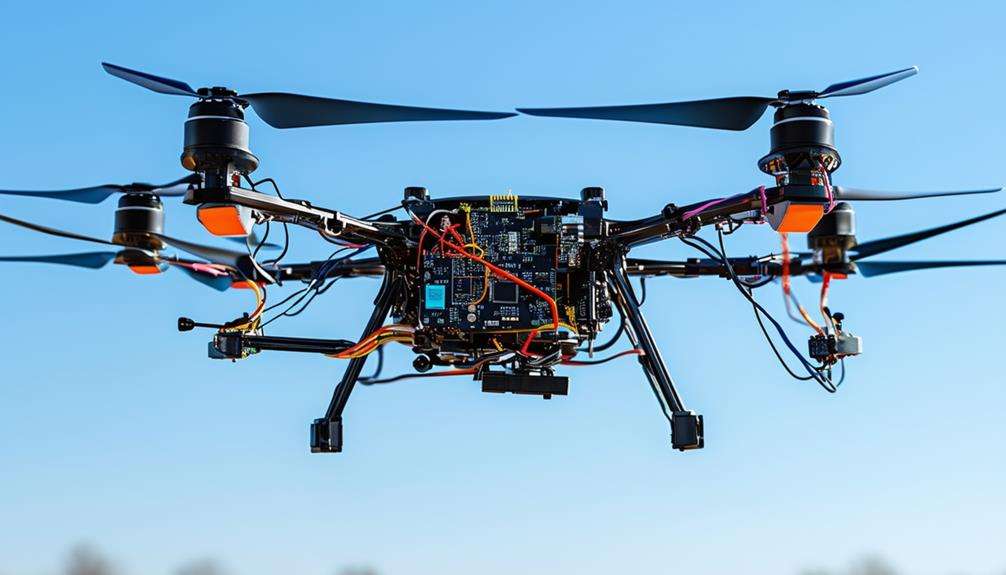
The flight controller acts as the drone's brain, managing inputs from the remote control, GPS, and various sensors to execute precise maneuvers. It plays a critical role in ensuring your drone flies smoothly and responds accurately to your commands. By integrating GPS technology, the flight controller can pinpoint your drone's location, enabling automated navigation and return-to-home functions.
Sensors are essential companions to flight controllers. They detect obstacles, adjust flight parameters, and enhance navigation capabilities. This technology allows you to fly your drone without worrying about collisions with trees or buildings. Advanced sensors, in conjunction with the flight controller, provide telemetry data that offers real-time feedback on flight parameters and performance, making your flying experience safer and more intuitive.
Here's a quick breakdown of the emotional experience you'll have with a well-coordinated drone system:
| Emotion | Experience | Feature |
|---|---|---|
| Confidence | Smooth, precise maneuvers | Flight controller |
| Relief | Automatic obstacle avoidance | Sensors |
| Assurance | Accurate positioning | GPS technology |
With flight controllers and sensors working together, you're not just flying a drone; you're piloting a sophisticated piece of technology designed to deliver the best possible experience.
Navigation Systems
Leveraging advanced navigation systems, your drone can autonomously set and follow precise flight paths using GPS coordinates. These GPS systems are crucial for waypoint tracking and automated return-to-home functions, ensuring your drone always knows its location and destination.
Infrared sensors and radar systems further enhance this capability by detecting obstacles and adjusting flight paths for safe navigation. Central flight controllers play a vital role in processing data from these sensors, ensuring accurate navigation. They integrate information from GPS, infrared sensors, and radar systems to maintain efficient flight paths.
This integrated system allows for real-time adjustments, ensuring your drone avoids collisions and navigates effectively.
Here's a quick summary of how these navigation systems benefit your drone:
- GPS: Provides precise positioning and automated return-to-home.
- Infrared sensors: Detect obstacles for safe navigation.
- Radar systems: Enhance obstacle detection and path adjustment.
- Central flight controllers: Integrate sensor data for accurate navigation.
- Waypoint tracking: Allows for pre-programmed, precise flight paths.
Stabilization and Control
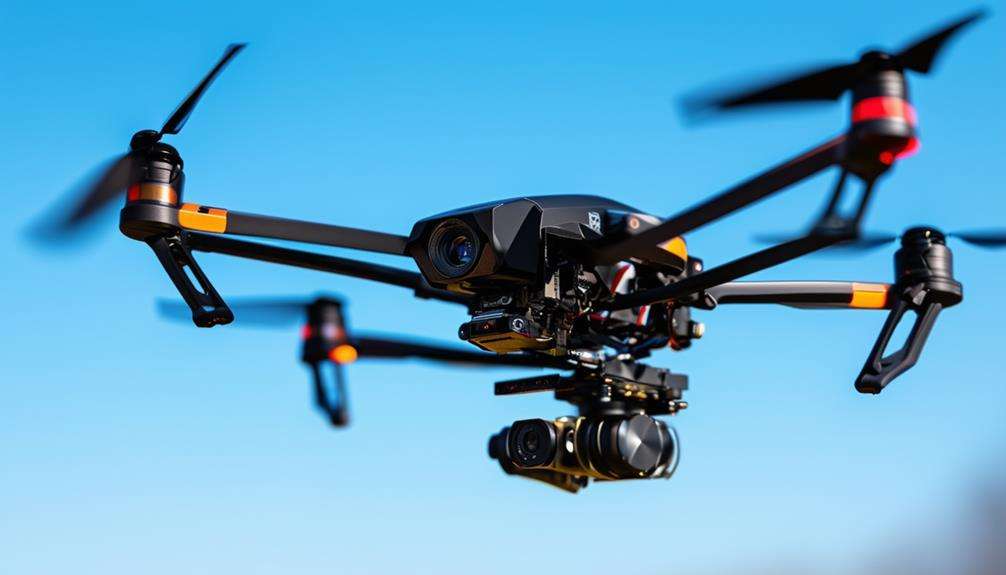
Maintaining stable flight, your drone relies on gyroscopic sensors and accelerometers to continually adjust its position and movement. These sensors provide real-time data to the flight controllers, which then make rapid adjustments to the speed of individual motors. This constant feedback loop ensures that your drone remains balanced and responsive to your commands.
Flight controllers act as the brain of your drone, processing information from the gyroscopic sensors and accelerometers to calculate necessary motor speed adjustments. This system allows your drone to hover steadily, even in windy conditions or during complex maneuvers.
Obstacle avoidance sensors add another layer of control by detecting objects in the drone's path. When these sensors identify a potential collision, they send signals to the flight controllers, which then adjust the drone's course to avoid the obstacle. This technology is crucial for safe, autonomous flying, especially in cluttered environments.
The integration of these technologies ensures that your drone can maintain stable flight, react quickly to environmental changes, and navigate safely. With such sophisticated stabilization and control systems, you can focus more on capturing stunning aerial footage and less on manual adjustments.
Drone Applications
Drones are revolutionizing various industries by offering innovative solutions for tasks such as aerial photography, emergency response, and more. In filmmaking, drones enable the capture of stunning aerial shots that were previously unattainable or too costly. In agriculture, drones assist in crop monitoring, health assessment, and precise spraying, enhancing efficiency and reducing labor.
Drones are also pivotal in surveillance. Law enforcement and security agencies use them to monitor large areas, manage crowds, and investigate crime scenes. In wildlife conservation, drones track animals, monitor habitats, and combat poaching, aiding in the protection of endangered species and maintaining ecological balance.
Emergency services benefit significantly from drone technology. Drones can quickly locate missing persons, evaluate disaster zones, and deliver essential medical supplies to remote locations.
Key applications include:
- Aerial shots in filmmaking
- Crop monitoring and spraying in agriculture
- Surveillance for law enforcement
- Wildlife conservation efforts
- Emergency response and medical supply delivery
Drones are enhancing efficiency and effectiveness across multiple sectors, transforming how we tackle diverse challenges.
Future of Drone Technology
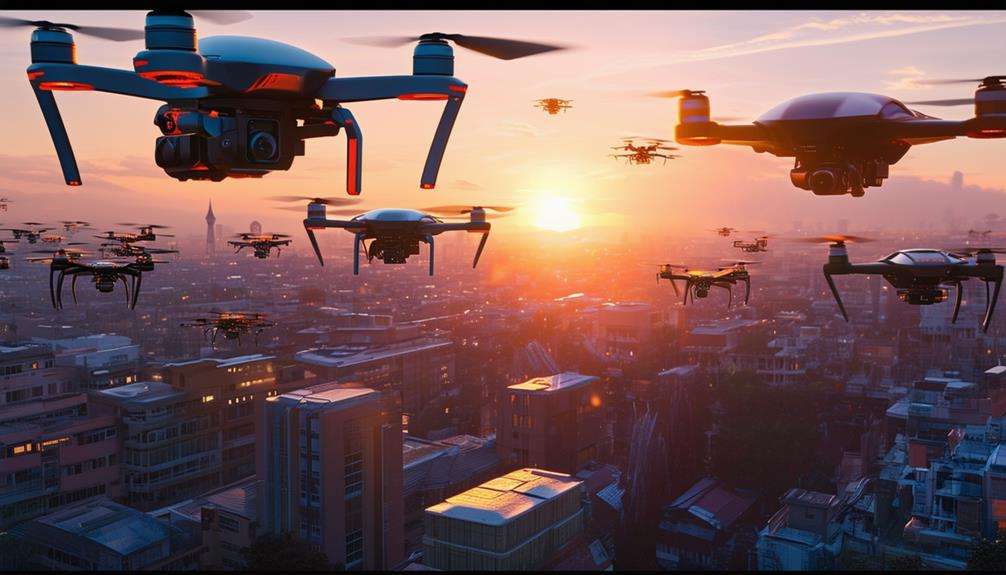
As drones continue to revolutionize various industries, expect even more groundbreaking advancements in drone technology. Autonomous flight capabilities will take center stage, with artificial intelligence playing a pivotal role. Imagine drones navigating complex environments and completing tasks without human intervention, greatly enhancing efficiency in sectors like agriculture, construction, and healthcare.
Advanced sensors such as LiDAR and multispectral cameras will enrich data collection and analysis, providing incredibly precise information. This will optimize crop monitoring, infrastructure inspection, and medical deliveries, making drones indispensable tools for data-driven decision-making.
Drone swarms are another exciting development. Coordinated groups of drones can work together on tasks like search and rescue missions or large-scale surveillance operations. The collective power of multiple drones operating in unison will enable complex, collaborative tasks.
Battery technology is also evolving, promising longer flight times and more extensive missions. As batteries become more efficient, drones will cover greater distances and stay airborne longer, enhancing their versatility and effectiveness in a range of applications.
Conclusion
You've gained a comprehensive understanding of drone operation, from propulsion systems to advanced navigation. With precise aerodynamics, dependable flight controllers, and sophisticated sensors, drones have become essential tools in various fields such as agriculture, logistics, and emergency response.
As technology advances, drones are expected to become even more efficient and versatile. Whether you're a hobbyist or a professional, the future of drone technology holds exciting developments that are worth monitoring.

